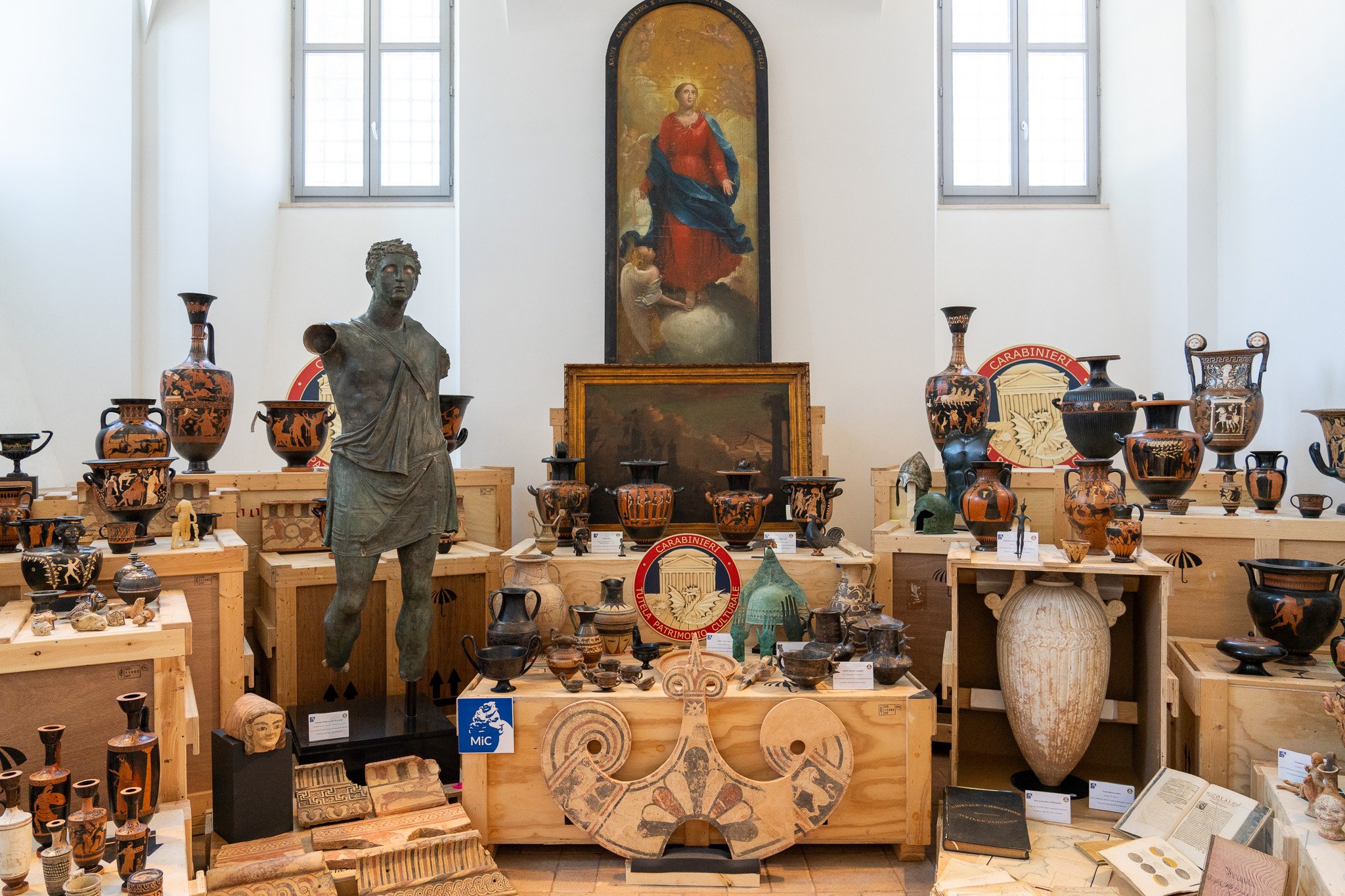
The Italian government has received 600 artifacts repatriated from the United States, collectively worth about €60 million ($65 million).
The artifacts were presented at the Central Institute for Restoration in Rome on May 28 after they were subject to a number of investigations conducted by the Carabinieri Command for the Protection of Cultural Property with assistance from the office of Manhattan District Attorney Alvin Bragg’s office and U.S. Homeland Security Investigations.
According to the Italian Culture Ministry, the artifacts were taken from Italy during “clandestine” excavations and thefts from churches, museums, and private owners. Some of the artifacts ended up in the possession of well-known U.S. museums and galleries, as well as in the hands of international traffickers.
Part of the 600 artifacts the U.S. repatriated to Italy. Photo: Emanuele Antonio Minerva © Ministry of Culture.
Luigi La Rocca, the director-general of archaeology, fine arts, and landscape in Italy, said that the investigations that led to the recoveries were codenamed “Operation Symes” after Robin Symes, a well-known international trafficker in ancient artifacts. La Rocca said the pieces were largely traceable to Symes.
“Despite the destruction of commercial documentation related to the international trade in archaeological material, the authorities involved have reconstructed the map of clandestine trafficking of the material excavated and exported from Italian territory, the subject of the extraordinary recovery in favor of the Ministry of Culture,” La Rocca said.
Part of the 600 artifacts the U.S. repatriated to Italy. Photo: Emanuele Antonio Minerva © Ministry of Culture.
During the investigations, authorities made use of an Italian cultural property database of about seven million objects as well as an artificial intelligence tool called the Stolen Works Of Art Detection System to search for missing works.
Culture Minister Gennaro Sangiuliano said the return of such artifacts to Italy makes it possible to “heal so many wounds,” while Gianmarco Mazzi, the ministry undersecretary, called it a testament to international cooperation with U.S. officials.
One of the 600 artifacts the U.S. repatriated to Italy. Photo: Emanuele Antonio Minerva © Ministry of Culture.
Director-General of National Museums Massimo Osanna said the artifacts would be housed in Italian museums. In the meantime, the ministry is hosting a temporary exhibition of the finds to “continue to stimulate young people’s sensitivity to fundamental issues such as legality and the value of our heritage.”
“Italy has an incredible cultural and artistic heritage,” U.S. Ambassador Markell said in a statement. “Its protection requires care and vigilance. The United States is strongly committed to safeguarding and preserving cultural heritage around the world.”
Notably missing from the items repatriated was Victorious Youth, a priceless sculpture currently held by the J. Paul Getty Museum in Los Angeles. Earlier this month, the European Court of Human Rights determined that Italy is the rightful owner of the sculpture. Homeland Security officials and investigators with the District Attorney’s office said in a statement to ARTnews that the statue is part of an ongoing investigation.
Part of the 600 artifacts the U.S. repatriated to Italy. Photo: Emanuele Antonio Minerva © Ministry of Culture.
The items that were repatriated span from about 900 B.C.E to about 200 C.E. A coin depicting Emperor Trajan, stolen in 1978 from the Oliverian Archaeological Museum, was retrieved from a Philadelphia auction house. Another depicting the wine gods Dionysus and Silenus, illegally excavated in Sicily in 2013 and secretly exported to the U.K., was seized in New York. Gold coins from the National Archaeological Museum were spotted in auction houses in New York, Dallas, Los Angeles, Chicago, and Puerto Rico.
The artifacts also included several busts and sculptures, including a cuirass and two bronze heads that were in the possession of well-known New York gallery owner; an Umbrian bronzetto of a warrior, stolen in a 1962 heist, was found in a museum; and a life-size bronze of a Hellenistic prince excavated in the 1970s was located in New Jersey.
Part of the 600 artifacts the U.S. repatriated to Italy. Photo: Emanuele Antonio Minerva © Ministry of Culture.
As for paintings, Giuseppe Pappini’s Our Lady of the Assumption (1851) was found in the possession of a Dallas gallery owner and seized by HSI. It is believed to have been stolen in May 2002 from a Benedictine abbey. A pair of oval oil paintings depicting flowers were taken from a private home in Cucciago in February 1997 and also seized by HSI from an auction house in Los Angeles. And an oil painting depicting a mediterranean harbor scene by Dutch artist Hendrik Van Minderhout, stolen in 2004 from a home in Salerno, was found at a gallery in New Orleans.